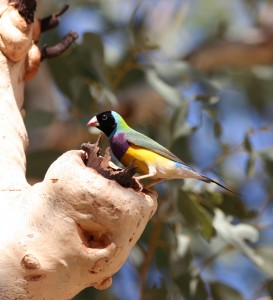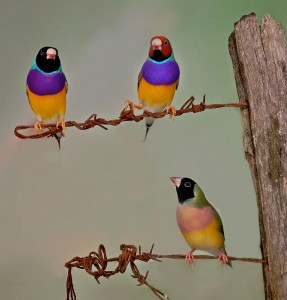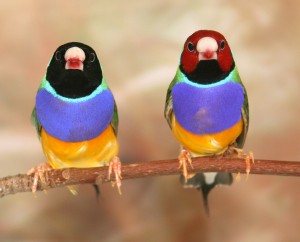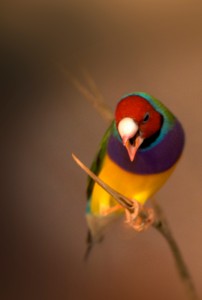In Gouldian finches the answer is yes-according to an Australian paper published in the journal Science today. The paper challenges our view of sex determination in animals.
“Over eighty per cent of Gouldian finch chicks will be male if their mother sees that the father has a different coloured head,” says the lead author Sarah Pryke, a L’Oréal Australia For Women in Science Fellow and ARC Fellow at Macquarie University.
The key word is ‘sees’-the change isn’t due to any chemical or genetic interaction between the parents. Simply change the colour of the male’s head with hair dye and the female subconsciously changes the sex ratio of her offspring.
“This discovery will change our understanding of sex determination across the animal kingdom,” says Sarah.
“Gouldian finches wear their genes on their head. These colourful native birds have three possible head colours-red, yellow and black. So it was relatively easy to construct an experiment to determine the influence of head colour on sex.”
“We expected some influence on sex ratio,” she says, “but it was a surprise to find that 82.1 per cent of the offspring were male.”
Why is it so? “Daughters produced from mixed matings-where parents differ in head colour – suffer from genetic incompatibilities between their parents that cause about 84 per cent to die young,” says Sarah.
So it’s in the finch’s best interest to mate with a male with the same head colour. If a female has no other option but to mate with a male of different head colour, she will produce mainly sons to maximise the chicks’ chances of survival. Only a few thousand Gouldian finches remain in the wild-all in the remote northern savannas of tropical Australia. So Sarah and her colleagues worked with a captive breeding colony established by the Save the Gouldian Fund at Martinsville in the Hunter Valley, north of Sydney.
“This study highlights just how little we know about this iconic Australian species. The results have important implications for how we conserve and ultimately save this finch,” says the director of the Fund, Mike Fidler.
The remaining wild Gouldian finches live in small mixed groups containing the different head colours. “We need to increase the connections between groups to give the finches more opportunities to mate with birds with the same head colour,” Sarah says.
“This is a fascinating discovery and an interesting connection in that L’Oréal is celebrating 100 years since Eugene Schueller founded the company just two years after inventing the first synthetic hair dye. However I don’t think we’ll be extending our product claims just yet!” says Megan Ryan, Corporate Communications Manager for L’Oréal Australia.
Notes:
The research was conducted with the support of: a $20,000 L’Oréal For Women in Science Fellowship; the Save the Gouldian Fund; and the Australian Research Council.
L’Oréal has no influence on the research directions of its Fellows or the publication of their work. A removable dye was used for the research; it was not a L’Oréal product.
Reference: Sarah R. Pryke* and Simon C. Griffith, Genetic incompatibility drives sex allocation and maternal investment in a polymorphic finch, Science Vol 324, 2009.
Sarah Pryke received one of four L’Oréal Australia Fellowships in 2007. Applications for the $20,000 2009 Fellowships open 1 April 2009.
- Further information at www.scienceinpublic.com/blog including background story, profile and photographs.
- For interviews Sarah Pryke 0431 746 276; Megan Ryan 0400 641 737; Niall Byrne (03) 9398 1416, 0417 131 977; Sam Norris (02) 9850 9658.
- Photos are below.
Could your hair colour determine your child’s sex: background information
Written by Tim Thwaites for Science in Public and L’Oréal
Small, brightly coloured Gouldian finches come in three varieties with different coloured heads. About 70 per cent have black heads, about 30 per cent red and less than one per cent yellow.
Like human hair colour, the colours are directly genetically determined but, unlike humans, there are no intermediates.
Sarah Pryke, an ARC Research Fellow in the Department of Brain, Behaviour and Evolution at Macquarie University, has being trying to work out why the three forms persist, and what advantages and disadvantages the colours confer. Normally you would expect natural selection to favour one colour over the others-as is seen in most species.
In previously published work she has found significant differences in the behaviour of the three forms.
The red-head males are the most aggressive and dominate the other forms, selecting the best nest sites and having the best access to food and mates. But that does not necessarily mean they have the greatest breeding success.
The red-heads spend so much time fighting other males that they contribute very little to parental care and are constantly under stress.
The offspring of the laid-back black-heads may not be born into such a high-class neighbourhood, but they see more of their father.
Pryke has been able to link these behavioural differences to differences in physiology.
The red-heads have much higher levels of testosterone, for instance. So what she is finding is that the balance of the colours is reflected in a balance of advantages and disadvantages in the community within which the birds live.
Interestingly, even though all the head forms are considered one species and live together, Pryke has also found a genetic incompatibility when different head forms breed.
In the wild, mating between different head colours occurs in about 30 per cent of pairs. But studies on a captive population, established by the Save the Gouldian Fund in the Hunter Valley, show that the sons produced from such mixed matings have about a 40 per cent greater chance of dying during development than sons from pairs of the same head colour. Worse, daughters are about 84 per cent more likely to die.
Given the enormous disadvantage of mixed pairings, Pryke predicted that female Gouldian finches forced to mate with males of different head colour would adjust their breeding habits to minimise their energy investment and maximise the survival rate of the chicks.
In practical terms, they should put less into breeding and, if possible, should skew the sex ratio to produce more males than females.
At the breeding colony, she and her colleague Simon Griffith paired 100 black- and 100 red-headed females randomly with males of the same or different coloured heads.
The selected pairs were put into breeding cages, where they were unable to see or have any contact with other birds. As the finches can produce at least two clutches of eggs a year, the females were also bred later with a male of the other colour.
Females paired with mates of different head colours laid fewer and smaller eggs, and did not care as well for their offspring. Even more interesting was the fact that the broods of mixed pairs (red-black) were about 82 per cent male, while the broods of pairs of the same head colour were about 46 per cent male.
To test whether this was simply an artefact of the genetic incompatibility between the head forms or was actually under complete control of the mother, the researchers were able to go even further by tricking the females.
They artificially switched the colours of red- and black-headed males using non-toxic pigment applied to the head feathers. The females reacted as if the head colour changes were real, and adjusted the sex ratios accordingly.
This experiment showed that the trigger for biasing the sex ratio is purely visual. It was as if a subconscious switch were thrown.
This result is something of a Holy Grail in zoological theory.
Until now, although sex ratio adjustment as an adaptive response to external circumstances had been proposed, it had not been convincingly demonstrated.
Pryke and Griffith have provided the first clear evidence of its occurrence.
“These are very exciting results, because they demonstrate hitherto unsuspected degrees of control over reproductive investment by female birds,” says Prof Ben Sheldon of Oxford University’s Edward Grey Institute of Field Ornithology.
“This work opens new possibilities in unravelling the mechanisms behind these striking behaviours, something which has up to now remained an unsolved mystery.”
And the study is important for conservation of the Gouldian finch too. Only a few thousand remain in the northern savannas of Australia in small populations containing the different head colours.
The probability of pairing with a male of a different colour is much higher in a smaller population of finches where the number of alternative mates with the same head colour is limited, Pryke says.
“So this makes us aware that small populations are a problem. Unless we increase the connections between populations, Gouldian finches are likely to go extinct a lot quicker.”
- Further information at www.scienceinpublic.com/blog including background story, profile and photographs.
- Applications for the 2009 Fellowships open 1 April 2009.
- For interviews Sarah Pryke 0431 746276, Megan Ryan 0400 641 737, Niall Byrne (03) 9398 1416, 0417 131 977
About the L’Oréal Australia Fellowships
L’Oréal Australia’s For Women in Science Fellowships were first awarded in 2007.
In 2009 three early career women will each receive a $A20,000 fellowship.
Nominations for 2009 will open on 1 April.
Further information at www.scienceinpublic.com/loreal



